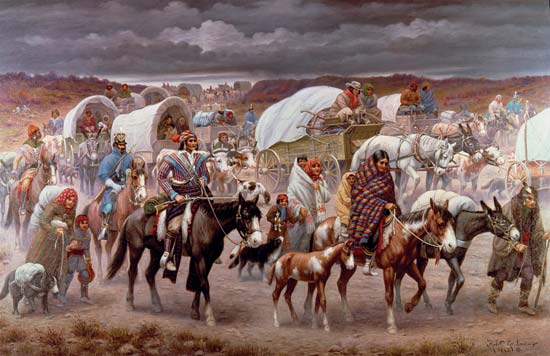Many Indians however
但是還有不少印第安人
wanted to pursue their tribal life,
希望追求部落生活
liberty and happiness
同時也想要自由和快樂
as inhabitants of the United States
就像那些祖祖輩輩一直居住在
right where their people had been living for centuries.
美國的印第安土著一樣
The Constitution granted them that right, supposedly.
美國憲法算是給了他們這個權利

The so-called Indian question.
所謂的印第安人問題
The conflict over Indian removal started in 1802
印第安人被迫遷徙的沖突始于1802年
when the Georgia legislature gave up all claims
當時喬治亞州決定永久放棄
to territory west of Georgia for good.
它西邊的所有領土
In return the United States government
作為回報,美國政府
pledged to eliminate all Indian titles
保證剝奪喬治亞州內
to land inside Georgia.
所有的印第安人的土地
The Georgians were particularly concerned
喬治亞洲人尤其針對
with the Cherokee people
切羅基族人
which occupied a large chunk of land
他們占據了喬治亞州內
inside the state of Georgia.
大片的土地
The Cherokee had adopted many western ways
切羅基族人已經采用了許多西方人的手段
including the enslavement of blacks
包括奴役黑人
and had settled into
而且也發展了南方的
the south's cotton planting economy.
棉花種植經濟
In 1827 the Cherokee adopted a written Constitution
1827年,切羅基族人根據一項成文法
declaring themselves a sovereign nation
宣布他們是一個主權國家
with complete jurisdiction
對其領土及人民
over its territory and people.
擁有司法裁判權
Georgia did not recognize the Cherokee Constitution
喬治亞州不承認切羅基族人的憲法
seeing the Cherokees as
并且把他們看做
nothing more than illegal squatters.
違法占用土地的人
In 1827 the Supreme Court ruled against the Cherokee
1827年,最高法院決定支持喬治亞州
supporting Georgia's claim.
作出不利于切羅基族的裁決
The Cherokee returned to the Supreme Court in 1831.
切羅基于1831年重返最高法院
This time they got a decree
這一次他們得到了新的判決
granting them self-government
判決不僅承認他們的自治
and the decree also declared
還聲明
Georgia's opposition was unconstitutional.
喬治亞的抗議是違憲的
However Georgia refused to abide by
但是喬治亞拒絕遵守
the Supreme Court decree.
最高法院的判決
President Andrew Jackson, Old Hickory,
安德魯·杰克森總統
was an old Indian fighter himself
是一名印第安老戰士
and he refused to enforce
他也拒絕實施
the Supreme Court's decree also.
最高法院的裁決
In practice the Constitution's pattern of
實際上,憲法的
checks and balances did not apply
分權與制衡功能
when it came to American Indians.
在印第安人問題上并沒有起作用
The Jackson administration's answer
杰克森政府對印第安問題
to the Indian question was the Indian Removal Act
的回應就是印第安人遷移法
signed by President Andrew Jackson in 1830.
于1830年由安德魯·杰克森總統簽署
This act enabled the president to quote/unquote
此法讓總統能夠
"negotiate removal treaties with all Indian tribes
"與密西西比河以東的印第安部落
east of the Mississippi River."
協商遷移的條約"
The Indians would trade their lands
印第安人會用
east of the Mississippi
密西西比河以東的土地
in exchange for lands west of the Mississippi.
用來交換密西西比河以西的土地
Those Indians who wished to stay
那些希望留在
where their ancestors had lived for centuries
祖先生活的地方的印第安人
would have to fall under the laws of that state
就必須服從所在區域
which claimed their territory.
州政府的律法和管理
Jackson claimed that the Indian Removal Act
杰克森聲稱,印第安人遷移法
would protect the Indians
能保護印第安人
and allow them to quote/unquote
并讓他們能夠
"become civilized by adopting western ways."
"通過學習西方的方式成為文明人"
Eventually almost all of the Native Americans
最終,大部分的印第安土著
were forced to move west.
都被迫西遷
Ethnic Cleansing, American style.
美國式的種族清洗
The most famous of these Indian removals
最臭名昭著的一次印第安人遷徙
became known as the Trail of Tears
被稱為"血淚之路"
in which 12,000 Cherokee were forced to
12000名切羅基族人被迫
trek over 800 miles to their new lands.
跋涉超過800英里到新的居留地
Along the way over 4,000 died of famine and disease.
途中超過4000人死于饑餓和或疾病











